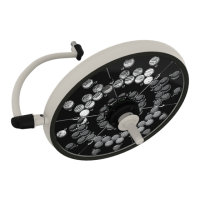19
S
6. Cleaning and Sterilization
6.1 Cleaning the Suspension Apparatus
Caution
• Power o the system during cleaning. Make sure that no cleaning uid enters the system.
• To avoid damage to plastic and painted surfaces, do not use any scouring, alkaline, acidic, or
alcohol-based cleaning agents.
Note:
• Cleaning and disinfecting must be performed by trained personnel. Follow the
requirements of the national committee responsible for hygiene and disinfection. It is
the user’s responsibility to qualify any deviations from the recommended method of
processing.
• Any modications to these parameters should be based on standard hospital cleaning
protocol, and are performed at the discretion of the user, who assumes the risk for
modifying these parameters.
Point of Use Wipe excess soil from all suspension components using disposable paper
towels.
Preparation
for Cleaning
Properly prepare a cleaning agent according to the detergent manufacturer’s
recommendations.
Cleaning agents may include:
• Enzol Enzymatic Detergent
• Quaternary Ammonium
• Isopropyl Alcohol
• Amphyl II Spray
• Soap and Water Solution
• Bleach and Water Solution
Cleaning:
Manual Method
1. Remove debris from all surfaces by applying the cleaning agent to a
clean, soft, lint-free cloth and wiping each component of the suspension,
including product labels.
2. Dry the suspension apparatus with a lint free cloth. For most eective
results, remove excess solution that may have collected in hard to reach
areas and equipment creases.
Disinfection Not applicable
Maintenance,
Inspection, and
Testing
Inspect suspension apparatus before and after use. Do not continue using
equipment if it is damaged. Damage includes cracks, chips, holes, tears,
or anything else that might interfere with the integrity of the suspension
apparatus.

